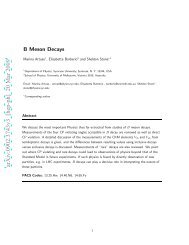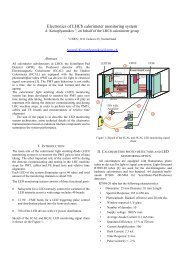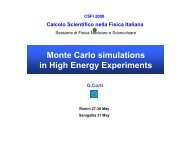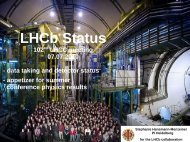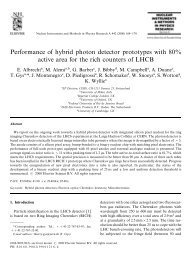Create successful ePaper yourself
Turn your PDF publications into a flip-book with our unique Google optimized e-Paper software.
<strong>Stefan</strong> <strong>Koestner</strong><br />
on behalf of the<br />
LHCb Silicon Tracker Collaboration<br />
IEEE - Nuclear Science Symposium<br />
ROME, Oct. 20<br />
<strong>Stefan</strong> <strong>Koestner</strong> IEEE NSS – Rome 2004<br />
th 2004
-<br />
angular distribution of bb-pairs → forward spectrometer (15-300 mrad)<br />
either forward or backward → single arm<br />
<strong>Stefan</strong> <strong>Koestner</strong> IEEE NSS – Rome 2004
TriggerTracker + InnerTracker =<br />
SiliconTracker<br />
<strong>Stefan</strong> <strong>Koestner</strong> IEEE NSS – Rome 2004
• 4.3m 2 silicon<br />
• 1.3% of total acceptance<br />
20% of reconstructed tracks<br />
• operation at ~5°C<br />
<strong>Stefan</strong> <strong>Koestner</strong> IEEE NSS – Rome 2004<br />
• 4 individual boxes per station (3 in total)<br />
• 4 layers per box (2 stereo layers ±5º )<br />
• 2 module types: 11 and 22cm long
• p-on-n silicon micro-strip sensors (HPK)<br />
• 108 mm long strips<br />
• 384 readout strips<br />
• 320 (410) µm thickness<br />
• 198µm pitch<br />
• w/p=0.25<br />
Hybrid:<br />
(2 nd sensor<br />
not shown)<br />
• 3 Beetle preamps<br />
• 0.25µm CMOS<br />
• 40 MHz clock<br />
• programmable<br />
shaping time (V fs)<br />
<strong>Stefan</strong> <strong>Koestner</strong> IEEE NSS – Rome 2004<br />
cooling “balcony”<br />
CF-support<br />
pitch-adapter
• hybrids with Beetle readout at<br />
the edge outside of the acceptance<br />
• inner modules connected via<br />
Kapton interconnect cables<br />
• operated at ~5°C<br />
<strong>Stefan</strong> <strong>Koestner</strong> IEEE NSS – Rome 2004<br />
• 4 layers in 2 half stations<br />
• 2 layers ±5º stereo angle<br />
• 7.9m² silicon<br />
• readout sectors with<br />
1,2,3 and 4 sensors
• CMS-OB2 sensors design (HPK)<br />
• 183 µm pitch, w/p=0.25<br />
• 500 µm thickness<br />
• 4 sensor ladder → 38cm<br />
• 3 sensor + 40cm Kapton<br />
• 1 sensor + 58cm Kapton<br />
silicon<br />
sensors<br />
<strong>Stefan</strong> <strong>Koestner</strong> IEEE NSS – Rome 2004<br />
readout hybrids<br />
Kapton interconnects<br />
CF rails<br />
additional load capacitance!<br />
up to 57pf → minimize for S/N<br />
(IT 35 pf)
120 Gev pions @ CERN X7<br />
• TB 2003:<br />
- choose w/p & thickness of sensors<br />
- studying shaping parameters → spill over<br />
ladders of different length & thickness:<br />
320 µm - multigeometry, 410 µm - Glast, 500 µm - CMS<br />
• TB 2004:<br />
- confirmation of extrapolations (prototypes)<br />
- irradiation tests<br />
(3 sensors + Kapton flex cable, Lhcb @ 10yrs radiation)<br />
<strong>Stefan</strong> <strong>Koestner</strong> IEEE NSS – Rome 2004<br />
In addition<br />
laser measurements
<strong>Stefan</strong> <strong>Koestner</strong> IEEE NSS – Rome 2004<br />
Landau-Gauss Convolute for S/N:<br />
1-sensor (320µm, 198 µm pitch) → 15 �<br />
2-sensor (320µm, 198 µm pitch) → 11<br />
IT-2 sensor ladder 410 µm �<br />
3-sensors (500µm, 180µm pitch) → 19<br />
�<br />
S/N spatially resolved<br />
left strip right strip
almost full efficiency at a<br />
noise rate ~0.04%<br />
<strong>Stefan</strong> <strong>Koestner</strong> IEEE NSS – Rome 2004<br />
Landau-Gauss Convolute for S/N:<br />
1-sensor (320µm, 198 µm pitch) → 15 �<br />
2-sensor (320µm, 198 µm pitch) → 11<br />
IT-2 sensor ladder 410 µm<br />
3-sensors (500µm, 180µm pitch) → 19<br />
�<br />
• efficiency dip for 3 sensor<br />
ladders with 320 µm<br />
• for higher S/N full efficiency also 500µm<br />
between strips 320µm (3 sensors)<br />
�
25ns<br />
signal remainder<br />
requirements less than:<br />
• 50% (TT)<br />
• 30% (IT)<br />
<strong>Stefan</strong> <strong>Koestner</strong> IEEE NSS – Rome 2004<br />
• load capacitance affects pulse shape<br />
signal remainder 25ns after peak<br />
→ spill over (BX 25ns)<br />
longer<br />
shaping time:<br />
• less noise<br />
• more remainder
ENC/e -<br />
Fit:ENC=770e - +47.9e - /pF<br />
Lab:ENC=580e - +48.8e - /pF<br />
C/pF<br />
• full charge collection efficiency (CCE)<br />
at 300 V for 500µm ladders<br />
• S/N dip does not disappear with overdepletion<br />
• no significant charge loss in 320µm (IT)<br />
after 10yrs. irradiation (1 Mrad or<br />
9·10 12 Neut.equiv.) full CCE at ~350V<br />
<strong>Stefan</strong> <strong>Koestner</strong> IEEE NSS – Rome 2004<br />
• noise dependent on load capacitance<br />
• extrapolations done from testbeam 2003<br />
for long TT ladders with Kapton flex<br />
confirmed by prototype in testbeam 2004<br />
(analysis ongoing)
Detecting defects in sensors:<br />
(shorts, broken bonds, pinholes)<br />
Noise pattern not always significant,<br />
confusing, dependent on grounding!<br />
• defects cause change in load<br />
→ response of Beetle<br />
signal height & shaping time<br />
• using internal calibration pulses<br />
→ no additional hardware required<br />
short<br />
broken<br />
<strong>Stefan</strong> <strong>Koestner</strong> IEEE NSS – Rome 2004<br />
PCB pick-up<br />
� high significance in detecting and identifying various defects
<strong>Stefan</strong> <strong>Koestner</strong> IEEE NSS – Rome 2004<br />
Fitting turned out to be tricky:<br />
• Model Beetle in Laplace space<br />
• convolute non-ideal preamp & CR-RC shaper<br />
• Inverse Laplace to obtain parametrization<br />
in time domain<br />
L(<br />
s)<br />
=<br />
Q<br />
C<br />
f<br />
1<br />
1+<br />
s ⋅τ<br />
pre<br />
1<br />
•<br />
1+<br />
s ⋅ ( RC)<br />
high<br />
s ⋅ ( RC)<br />
•<br />
1+<br />
s ⋅ ( RC)<br />
3 poles → 3 fit parameters<br />
low<br />
(returns ~15ns shaping time)<br />
low
short<br />
<strong>Stefan</strong> <strong>Koestner</strong> IEEE NSS – Rome 2004<br />
Fitting turned out to be tricky:<br />
• Model Beetle in Laplace space<br />
• convolute non-ideal preamp & CR-RC shaper<br />
• Inverse Laplace to obtain parametrization<br />
in time domain<br />
peakheight remainder<br />
broken bond<br />
distribution of<br />
response in<br />
3-sensor ladder<br />
3σ
Pinholes less easy to detect - but Beetle seems to be stable at high leakage<br />
Operating at -0.5 Volts bias affects response (currents, working point)<br />
<strong>Stefan</strong> <strong>Koestner</strong> IEEE NSS – Rome 2004<br />
• Even found defects we were<br />
not aware of!
• Presented current design of Silicon Tracker<br />
• Geometry for silicon sensors is finalized<br />
- wide pitch ~200µm<br />
- long strips up to 38 cm / 28cm+40cm Flex<br />
- fast readout (25 ns)<br />
• Test-beam performance satisfies requirements<br />
- fast shaping → spill over<br />
-sufficient S/N → efficiency<br />
- S/N of long Kapton Flex ladder as expected<br />
- irradiated ladders (320 µm @ 10yrs LHCb)<br />
fully depleted and sufficient S/N<br />
• Pre-Production start up soon<br />
- able to detect defects at high significance<br />
<strong>Stefan</strong> <strong>Koestner</strong> IEEE NSS – Rome 2004
Backup – Slides:<br />
<strong>Stefan</strong> <strong>Koestner</strong> IEEE NSS – Rome 2004
• ∆p/p ~0.4%, mass resolution 14 MeV →pitch<br />
• density ~5*10^5 cm¯²s¯¹ (beam-pipe) →granularity<br />
•~100% hit finding efficiency → thickness<br />
•~1% occupancy → strip length<br />
• pt in TT used for L1 for better<br />
minimum bias retention<br />
<strong>Stefan</strong> <strong>Koestner</strong> IEEE NSS – Rome 2004
short<br />
broken bond<br />
<strong>Stefan</strong> <strong>Koestner</strong> IEEE NSS – Rome 2004<br />
Fitting turned out to be tricky:<br />
• Model Beetle in Laplace space<br />
• convolute non-ideal preamp & CR-RC shaper<br />
• Inverse Laplace to obtain parametrization<br />
in time domain<br />
peakheight remainder<br />
(first-middle sensor)<br />
broken bond<br />
distribution of<br />
response in<br />
3-sensor ladder<br />
(negative polarity)<br />
(last-middle sensor)<br />
2σ after 1 st iteration
<strong>Stefan</strong> <strong>Koestner</strong> IEEE NSS – Rome 2004



